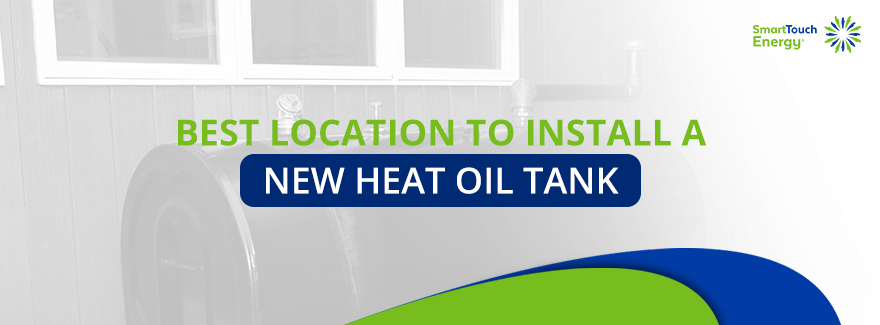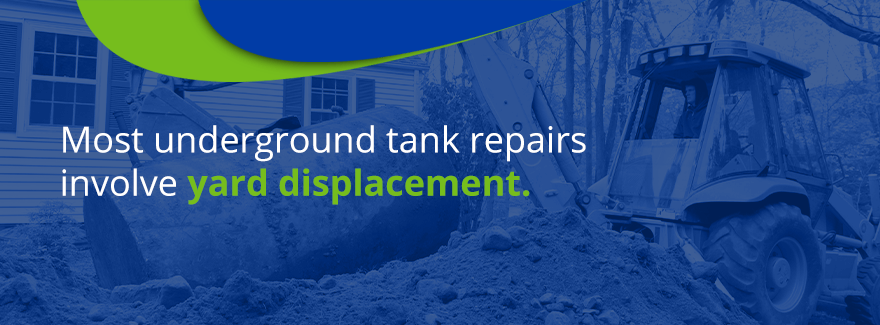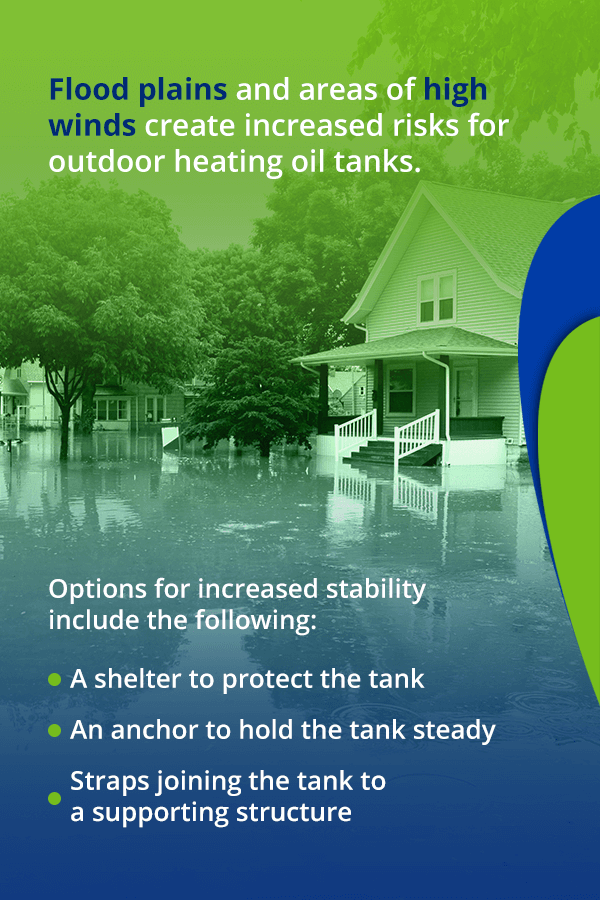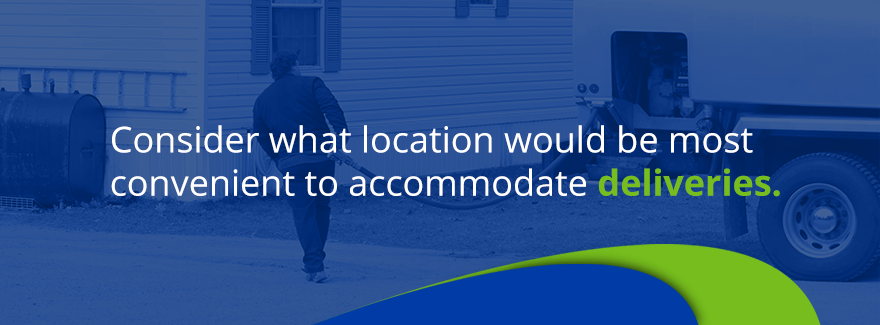
You rely on your heating oil tank to store the oil you need to keep you warm all winter long. Winters in the Northeastern United States can be bitter, so having enough oil on hand is paramount to your family's comfort. Thoughts of your oil tank may slip your mind throughout the year, but if you run out of oil or the tank malfunctions, it suddenly becomes a prevalent issue.
- Where Should I Install My New Heating Oil Tank?
- National Fire Protection Association (NFPA) Guidelines for Oil Tank Locations
- Best Location for an Oil Tank: Consider These Factors
- Contact Smart Touch Energy for More Information
Where you store your heating oil tank actually plays a big role in your experience of heating your home. If you're in the market for a new heating oil tank, you may be wondering about the best place to put it. Be sure to make a choice that meets your family's needs while keeping both the tank and your loved ones safe.
Where Should I Install My New Heating Oil Tank?
You should consider several factors when choosing a location for your new heating oil tank. Each setup has its own benefits that may suit your needs. Some may be out of the question, while others could be perfect for you. It all depends on your preferences, your ability to follow guidelines and the type of experience you want.
You can break down heating oil tank locations into the following four types:
- Outdoor
- Indoor
- Above-ground
- Underground
Let's take a closer look at these four installation styles to help you determine which is right for your family's needs.
1. Indoor Oil Tank Installation
An indoor heating oil tank is like the name sounds — it goes inside your home, often in a utility closet or other unoccupied area of the home. In ideal circumstances, your oil tank will rest in the basement. Indoor oil tanks are safe from the elements and the drastic temperature shifts of the outdoors, sparing them from rust and other issues.
Indoor oil tanks last longer than the outdoor variety, often having life spans up to 20 years with proper care and maintenance. And since the tank is indoors, you'll have an easier time checking on it for any leaks or malfunctions. At the same time, if your oil tank does experience a rare leak, it will happen within your home, which could be an unattractive idea.
2. Outdoor Oil Tank Installation
Outdoor tank installations can be either above ground or underground. This type of installation offers the peace of mind of storing your tank somewhere outside of your home. An outdoor tank provides some safety benefits in the event of an oil leak or fire, especially if you have children or pets. Plus, you'll experience greater convenience during oil deliveries since the driver can access your tank at any time without having to enter your home.
But keeping your oil tank outdoors requires a few considerations. These include:
- A shorter lifespan
- Greater susceptibility to rust and natural damage
- Malfunctions from inclement weather and temperature extremes
After weighing your options, if an outdoor tank is right for you, then your next step is to determine if you want your tank to be above ground or underground.
3. Above-Ground Oil Tank Installation
Above-ground oil tanks are entirely above ground and exist outside of the home on a solid concrete pad or other firm surfaces. Repair technicians have an easier time accessing and inspecting above-ground tanks due to their exposed components. They're also easy to install, making them a popular option for people getting a new oil tank.
Keep in mind that above-ground oil tanks are susceptible to the weather. Without a structure to cover the tank, it is at a higher risk of rust, pitting and other forms of damage that could affect its performance. Above-ground tanks also take up space on your property, which may cause you to choose an indoor or underground location for your new heating oil tank.
4. Underground Oil Tank Installation
If any part of the tank is beneath the earth's surface — the tank, its components or the lines — then it qualifies as an underground oil tank. Underground tanks, like indoor tanks, enjoy a level of protection against the weather. Tanks that are completely underground are also discreet, keeping your property open without a bulky tank getting in the way of your landscaping.

Underground oil tanks have some accessibility issues. Since these tanks are underground, they are difficult to monitor for leaks. If you start experiencing a malfunction, inspections and repairs take a bit more time and effort. Most underground tank repairs involve yard displacement.
National Fire Protection Association (NFPA) Guidelines for Oil Tank Locations
Whatever location you choose for your new oil tank, you'll have to follow NFPA 31 guidelines to keep your tank, your home and your property safer from fires. The NFPA's guidelines give specific instructions on where you can put your tank and what factors you must meet to comply.
1. Stability
Stability is an essential aspect of having a safe heating oil tank for your home. Here are some specifications for stability you'll have to meet when installing a new tank in your home or on your property:
- Bedding surfaces: The bedding surface of outdoor, above-ground tanks should consist of natural materials like sod or bark to prepare to aid in the new tank's stability.
- Concrete pads: You must pour a concrete pad in this area large enough for the tank to sit centered on the pad with room to spare. A firm area of concrete is ideal for oil tanks, making basements one of the best places for indoor tank storage.
- Subgrades: Build a subgrade of crushed stone to aid in natural water drainage around the concrete pad for outdoor tanks.
- Support legs: Every tank, inside or outside, should use strong support legs to keep it from moving in any direction.
2. Protection From Vehicles
Tanks should rest in areas far from regular vehicle traffic. You should not install your tank on or near your driveway or the public road near your house. The risk of a vehicle hitting an oil tank is too great to justify, leading the NFPA to create this regulation for increased safety.
Many people also wonder if their garage is a good place for an oil tank. Even if you park your car on your driveway — and especially if you park your car in your garage — you should never install your heating oil tank in the garage. This area is at too much of a risk of experiencing vehicle movement, raising your tank's chances of receiving damage.
3. Oil Supply Lines
The oil supply lines are the connection between your oil tank and your home. You need them for your furnace to receive oil to burn, creating warmth for your home. You must make sure these lines stay safe at all times from forces including heavy ice, snow or other objects that could break or pinch the lines, releasing oil. Install supply line covers to protect your lines from these and other risks.
Lines should be on declines to allow the smooth flow of oil from the tank to your home. This factor could influence where you place your outdoor oil tank. If your house is on the highest point of your property, then you may be unable to install an outdoor oil tank per NFPA's guidelines.
4. Additional Stability for High-Risk Weather Areas
Flood plains and areas of high winds create increased risks for outdoor heating oil tanks. The NFPA realizes that these conditions lead to unsafe scenarios, so you'll have to provide more stability to your tank if you live in such an area.

Options for increased stability include the following:
- A shelter to protect the tank from heavy snow, sleet, rain or other forms of precipitation
- An anchor to hold the tank steady during periods of high winds
- Straps joining the tank to a supporting structure
Make sure that any of the extra security measures you take are good for the tank itself. For instance, straps should not cause chafing or collect moisture on the tank, increasing its risk of rusting.
Best Location for an Oil Tank: Consider These Factors
Now that you know a bit more about the possibilities for oil tank locations — as well as the NFPA guidelines — you're on your way to making an informed decision about the location of your new tank. If you follow regulations, you can go with the option that is right for your family's unique needs. Consider the following personal factors to help you make a decision you can feel good about. Avoid making a decision you regret and choose the best location on your property from the start.
Safety
Keeping your family, your house and your property safe should be at the top of your list when considering a good location for your heating oil tank. Oil tanks are safe when treated with proper care and maintenance, but you should still consider all the possibilities to make a wise decision.
Storing your oil tank indoors will protect it from the elements, but keeping your tank outside may give you peace of mind in the event of a leak or other malfunctions. You may feel that an underground tank is the safest option, but that means your yard is at risk due to the installation and repair procedure. Choose the option that you feel best about — the one that keeps the things in life that matter to you safe.
Deliveries
You're going to use a lot of oil in all the years you rely on it to heat your home. Winters in the Northeastern United States can drop to frigid temperatures, causing millions of people to turn up their thermostats. You'll need at least a few oil deliveries throughout the year to keep up with your heating demands. Consider what location would be most convenient to accommodate those deliveries.

Ask yourself these questions:
- Do I want to provide access to the tank for every delivery?
- Will the tank be in an area of the home I can leave open for the delivery person so they can come at their convenience?
- Would I rather have the tank outside for easy deliveries to fit a busy schedule?
- Do I have a location outside that meets NFPA standards while still being accessible by the oil delivery person?
Landscaping
If you put great amounts of effort into keeping your yard beautiful throughout the year, you may be hesitant to choose the outdoors for your heating oil tank's location. The appearance of your landscape affects your experience of your home. If you can avoid installing an oil tank on a concrete pad in the midst of your green grass, you will. But if you lack room in your house for an oil tank, putting your tank outside may be a necessity.
If you are unable to keep your tank inside your home, your first option is to choose an underground oil tank. Installing an underground tank involves digging into your yard, so you may prefer an above-ground tank. You can plant trees or shrubs in certain ways to conceal your tank, as long as you leave enough distance between the tank and the trees to follow NFPA regulations. Ask professional tank installers for ideas to install an above-ground tank while maintaining your yard's integrity.
Inspections
The location you choose impacts the ease at which you can inspect your heating oil tank. Inspections are critical as they can help prevent future issues and solve an existing concern before it becomes any more serious. Going years without an inspection can cause problems to pile on until you're left with extensive repairs.
You can observe your indoor or above-ground outdoor heating oil tanks on a regular basis. You'll have the ability to see any signs of damage or abnormality so you can call a professional right away to take a closer look. Underground tanks are much harder to inspect and repair. If you care about having easy access to your oil tank on any occasion, you may want to consider installing your tank indoors or above ground.
Size Limitations
In some instances, you may have limited options due to the size restraints of your yard or your home. You may want to keep your heating oil tank in your basement, but if you lack the space, you may have to shift your expectations. Or your yard could be too small to safely contain your oil tank, forcing you to bury it underground or put it inside your home.
In a way, these size limitations can help you decide on the right location for your oil storage tank. As long as it fits in a way that is safe for your home, the tank and your family, you'll be able to enjoy heat all winter long.
Contact Smart Touch Energy for More Information
At Smart Touch Energy, we care about your heating oil experience. We serve states in the Northeastern United States, from Maryland up to Maine. Whether you need a one-time delivery or you want to sign up for our automatic delivery service to experience more affordable prices per gallon, we're the energy company with the right services for you.
Contact us today to place your heating oil order.




